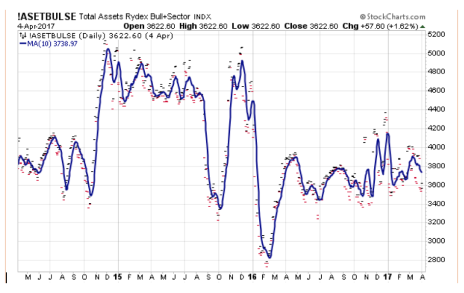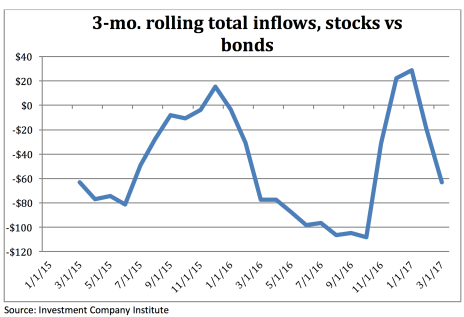The market’s rally was looking super-strong at the end of February, but March brought a good number of fundamental and technical question marks. That has some investors spooked that the bull run is almost over. According to two of my favorite stock market indicators, that’s hardly the case.
Fundamentally, we’ve seen inflation accelerate (raising the prospects of a more aggressive rate hiking campaign), first-quarter GDP expectations fall (the Atlanta Federal Reserve thinks Q1 GDP was up just 0.9%) and, of course, sloppiness in Washington, D.C., including the failure of the healthcare bill, which some believe could imperil tax reform.
Those and other negative headlines went hand in hand with some hesitation in the overall market—the S&P 500 (big caps), S&P 400 (mid caps) and S&P 600 (small caps) all finished slightly lower for the month. The bad news plus the market’s wobbles plus the market’s long advance (it’s now been about five months since the post-election kickoff) have convinced many investors that it’s time to bail out.




However, all of those worries are probably good news for the market.
I say that because stocks tend to climb a Wall of Worry—when the general backdrop for equities is positive (long-term uptrend, expanding economy, reasonable interest rates, etc.), the market tends to do better when there are things for investors to worry about.
Why? Because these worries keep many investors on the sideline. Over time, as more and more investors become convinced the market can keep rising, they buy, pushing prices higher. Once most people have turned bullish, that’s usually when buying pressures dry up.
Today, though, I don’t see much bullishness among investors based on a couple of my favorite stock market indicators, which track real money flows from a couple of different kinds of investors.
Stock Market Indicator #1
First, consider the total assets in all of the Rydex bull and sector funds (now owned by Guggenheim); these include index funds, leveraged long funds and some sector funds. Buyers of these funds tend to be shorter-term traders, jumping in and out every few weeks depending on their outlook.
Below is a chart showing the total assets in these funds during the past three years. (The line is actually a 10-day moving average to smooth out the daily gyrations.) You can see that in late-2014 and early-2015, when the stock market was topping out, assets in these bull funds totaled $4.6 to $5.0 billion. After a dip during the summer meltdown in 2015, they ratcheted right back up toward that $5.0 billion level … just before the market collapsed again in early 2016.
So where are we today, more than a year from the market bottom and five months into the post-election rally? Assets total $3.7 billion, which is below the middle of its three-year range and actually down 10% from the start of this year. As a measure of sentiment among aggressive investors, it’s clear many are still on the sideline!
Stock Market Indicator #2
For a broader view, I like to look at money flows to all domestic equity mutual funds and ETFs, and compare it to the money flows into all bond funds and ETFs. (Data comes from the Investment Company Institute.) If lots of money is flowing into bonds compared to stocks, it’s a sign of risk aversion—usually not something seen near major tops.
The chart below shows the three-month rolling total of net inflows to domestic equity funds minus inflows to bond funds. Numbers above zero mean more money has flowed into stocks than bonds, while negative numbers mean investors are buying bonds over stocks.
The first thing you notice is that, for just about all of 2015 and 2016, the amount of money flowing into bonds swamped that going into equities—there was a huge demand for safety. There was a brief change after the election, when stocks attracted some of investors’ attention, but since the start of the year, the desire for safety has reasserted itself—the past three months have seen $60 billion more flow into bonds than domestic equities!
Of course, both of these stock market indicators are secondary in nature to the price/volume action of the major indexes and leading stocks. But, along with some other longer-term stock market indicators I follow, money flows from both traders and investors point to this bull market still having a high Wall of Worry to climb in the months ahead.
With that in mind, I continue to think the market’s next major move is up, though in the short-term, it’s more of a coin flip as to what happens, especially with earnings season starting up in a couple of weeks.
Right now, when looking for stocks to buy, I’m leaning toward stocks that are being rotated into after consolidating for the past couple of months or longer. Some of these are major turnaround situations—Wynn Resorts (WYNN) is one name that I like that has recently gotten going, given that Macau is back in a growth phase.
Another stock I’m digging into is Vertex Pharmaceuticals (VRTX), a newly profitable biotech that recently soared on an excellent clinical trial. Here’s what I wrote about the company in this week’s issue of Cabot Top Ten Trader:
“For the past couple of decades, Vertex Pharmaceuticals was all sizzle and no steak—the firm’s various drug development projects always held promise, but except for a brief blip a couple of years ago, the firm has lost money. Now, though, Vertex has turned the corner, thanks to a leading position in the treatment of cystic fibrosis (CF), which all three of its approved drugs target—last year saw the firm’s revenues surge 65% as a couple of key drugs ramped up, while earnings came in at 85 cents per share. But that should be just the beginning of a long runway of growth.
“The stock is strong today because of a Phase III study on a combo therapy (that included one of the company’s drug prospects, called VX-661) released last week that showed a big improvement in lung function for CF patients 12 years and up with certain conditions. Vertex will submit a new drug application in the third quarter; once approved, it should greatly expand the company’s market potential. All told, analysts see sales up 20% this year and another 26% in 2018, and this time, much of that will fall to the bottom line, with earnings expected to rise 90% this year and next. Of course, the valuation isn’t for the faint of heart, but Vertex looks like the leader in CF, and now that profits are booming, more big investors should get involved—at yearend, Fidelity and T. Rowe Price own a combined 41 million shares, or about 16.5% of the company.”
After getting cut in half during an 18-month stretch, VRTX trended higher for the first three months of the year and then exploded to its highest level since early 2016 on the trial news. A pullback is possible, of course, but I’m thinking the trend has turned up—you could buy a little here or on dips and look to average up if the stock moves higher and the market does the same.
For more updates on VRTX and additional momentum stocks, consider trying out Cabot Top Ten Trader.

Learn More

Learn More

Learn More

Learn More


